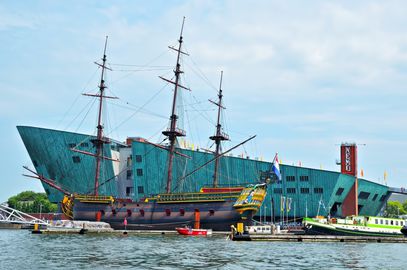

The striking copper-patina colored building in the shape of a ship rising above the Amsterdams eastern docklands and surrounded mostly by water is easily spotted. Designed by the Italian architect Renzo Piano, best known for his work on the Centre Georges Pompidou, the construction presented a major challenge: the museum had to be erected on top of a tunnel.
The curvature of the tunnel shaped the foundation and, subsequently, the bowed shape of the building itself. Above the traffic descending into the tunnel, the architect conceived a rising stepped piazza going 22 meters up. "Amsterdam is a one-dimensional city,"- surmises Piano in his working notes. He may have thought of Mediterranean cities where squares often overlook those cities from atop of a hill, and he may have felt that this is what Amsterdam was missing. Thus, he went on to endow Amsterdam with its own piazza in the shape of a broad 120-stepped terrace leading up to the bow of the green 'ship.
NEMOs roof terrace is the biggest one in Amsterdam and, in good weather, offers a spectacular panorama of the city. Theres a café and plenty of room to sit back, relax and enjoy a drink. In the summer months, 4000 liters of water cascade down the 30 pools and receptacles on NEMOs roof. Children are particularly fond of the Splashing Water Wonder which can be operated by turning the taps and the wheels. The top of the terrace is accessible by either climbing the steps or by taking the elevator from NEMOs entrance hall.
NEMOs exhibits are extremely informative as well as interactive. The architect chose for an interior that filters out distractions. The staircase is designed for optimum orientation, the walls are neutral grey and the number of windows have been kept to a minimum so as to focus the visitors attention on the exhibits. Renzo Piano refers to this concept as "the noble factory" and sees it as a counterbalance to the buildings more amusing exterior.
The exhibits popularly explain such engineering feats and phenomena as, for instance, bridge construction, origin of static in woolen sweaters, lightning, rainbows and optical illusions. The center also organizes workshops, film screenings and lectures. The historic old boats and barges moored alongside the eastern side of the NEMO are worth having a gander at. A number of them are houseboats and, thus, act as homes to local families. The engines and mechanisms opposite them are also curious items.